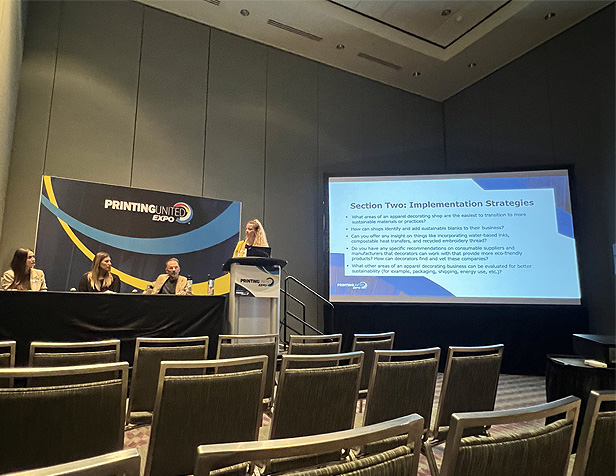Sustainability October 23, 2025
PRINTING United Expo 2025: Actionable Sustainability Steps for Apparel, Decorators & More
Apparel, decoration and print experts weighed in on how to make incremental changes toward a sustainable future.
Key Takeaways
• True sustainability in apparel goes beyond fabric choices. It includes ethical sourcing, thoughtful decoration and minimizing transportation emissions throughout the supply chain.
• Incremental changes like switching to LED lighting or reducing unnecessary shipping can have a significant long-term impact on both the environment and business operations.
• Extended producer responsibility laws and OSHA regulations are evolving, especially in states like California, signaling a broader shift that businesses must prepare for.
You don’t have to save the world single-handedly. You do, or at least should, have to turn the lights off when you’re not needing them.
Sustainability, as it relates to promo, print, apparel or even our daily lives as consumers and citizens, is measured in small increments rather than grand sweeping gestures. Short of a heroic scientific breakthrough, all we can do is do our part. Think globally, act locally, as the old saying goes.

In a panel titled “Sustainability Made Simple: Actionable Steps for Apparel Decorators,” Apparelist Content Director Cassie Green led industry experts through a discussion on how businesses can start their sustainability journey now.
In the printing, promo and apparel world, sustainability has never been more in focus than it is now. We’re more acutely aware than ever before of all the ramifications of climate change, and buyer habits are skewing toward companies that are sustainable.
However, sustainability should be more than just protecting your bottom line or appealing to a buyer demographic. And rather than focusing on the fear of consequences, even in spite of the challenges, there are opportunities if you look for them.
“Realize every day we have a choice,” said Eric Henry, CEO of TS Designs, at PRINTING United Expo this week. “The food you eat, the clothes you wear, the energy you use. Just be aware of that relationship you have. You’ll be more connected to the world you live in, and there will be opportunities to make a change.”
In a panel titled “Sustainability Made Simple: Actionable Steps for Apparel Decorators” moderated by Apparelist Content Director Cassie Green, Henry, along with Lane Seven Apparel (asi/66246) Director of Sales Milissa Gibson and PRINTING United Alliance EHS Affairs Coordinator Sara Osorio, drew from their experience and expertise, and educated attendees about how they can make a difference through their own businesses.
More Than Fabric
Conversations about sustainability and environmentalism in apparel tend to focus on the threads of the garment. But that’s not the entire manufacturing process, and it shouldn’t be the sole focus of an eco-conscious apparel brand or decorator.
In promotional marketing, where items are typically given out as gifts, there is the idea of avoiding the landfill and skirting the “trinkets and trash” designation. For apparel, that same idea applies, where decorators and designers need to create something for their clients not only for their customers’ brands to resonate but to also ensure that the garment has a long life.
“If we don’t do our jobs as decorators correctly, or put the right garment on the right person or project, it was all a waste,” Gibson said. “You can make the most sustainable thing, but if someone doesn’t wear it more than once, it’s pointless.”
Decorators, she said, are the last piece of the sustainability puzzle. It starts with sourcing an ethically manufactured product that uses eco-friendly materials, and it ends with the decoration process. That means the transportation involved, too.
“I think one of the most interesting things we’re not talking about as an industry is that you could make your shirt out of whatever you want – in reality, that’s not the problem,” Gibson said. “It’s how it’s being shipped. I work for a brand that’s guilty of this. We manufacture everything in Pakistan and ship it to Los Angeles, and then ship it to S&S, then ship it to the printer, who’s shipping it to the customer. The fuel alone for one garment, it’s not great. A lot of what’s happening with other brands is that they will manufacture their fabric in, let’s say, Vietnam. They’ll ship it to the U.S. to cut and dye, and then they’ll ship to Honduras to be sewn and ship it back to LA to sell, and they’ll claim they’re a green company. Let’s talk about it. Are you, though?”
Whether manufacturers, decorators and distributors are ready to have that conversation is sort of moot, as the ongoing tariffs situation will make the information known regardless.
“It’s all in your bill of materials,” Gibson said. “If your fabric is coming from China but your tag says Honduras, but your rate went up two times, that’s going to tell you something.”
Start at Home
Henry, who has spent decades on the environmentalism crusade, said that the first steps toward true environmentalism and sustainability have nothing to do with the garments or products you produce.
“Look at utility bills,” he said. “Our building was built 30-plus years ago. It was the best design at the time, but it was fluorescent tube lighting 20 feet up in the air. And our electric bill was nothing. It was a small line item because 30 years ago we weren’t talking about climate change. We’ve retrofitted all of those lights to LED, and we’ve lowered them down to task-specific levels.”
Technology for daily life moves fast, and younger generations are pushing the sustainability focus even further, so there’s really no excuse not to be on the up-and-up.
“These are small little things, but imagine that for 30 years,” he said. “They add up for the environment and for the bottom line.”
As he puts it, sustainability is not a destination, it’s a journey. Each step is part of the process, no matter how big.
Evolving Legislation
As the world focuses more on the responsibility of businesses and sustainability initiatives, more legislation has come to pass, especially in places like the European Union and certain states in the U.S. One of the legislative pieces that has affected both print – specifically packaging – and now apparel is extended producer responsibility (EPR).
It’s not a new concept. In essence, it places the financial responsibility for a product at the end of its natural life cycle on the producer, rather than consumers. It has been something the packaging world has had to pay attention to, but recently California adopted EPR legislation for textiles, a first for the U.S. market but likely not the last, according to Osorio.
“We do expect that to move forward in other states,” she said. “EPR is not a new concept. There’s EPR for batteries and EPR for paint. They’re relatively newer for textiles in the U.S., so it will be interesting to see how it’s implemented in California. We’re yet to see what the regulations are actually going to look like, but it’s coming to the U.S.”
She added that these trends have typically started in Europe and make their way to the U.S. through California. Sometimes, as they spread through other states, they vary slightly – look at PFAS chemical legislation as another example. The lack of cohesion or consistency from state to state can be a thorn in the side of businesses that sell to multiple states.
“If we look at what’s happening in packaging, every single state is different,” Osorio said. “There’s no continuity, and producers are having a lot of trouble trying to comply. So it’ll be interesting to see if other states go after California legislation or go in a different direction and we see the same issue we see on the packaging side.”
Aside from PFAS and EPR, Osorio said that the other great legislative evolution to pay attention to is OSHA compliance for apparel manufacturers and decorators that use Carousel presses. OSHA now wants full railings and protections around the presses for decoration businesses that use Carousel presses for apparel decoration.
Convincing the Naysayers
It’s hard to believe that in 2025 there are still those who don’t want to get on board with sustainability initiatives, but it’s the truth. Green ended her panel with a simple question to her panelists: How do you convince those who are hesitant to adopt sustainability practices to start?
Osorio argued that ignoring sustainability would only be cutting off your nose to spite your face, and that too many people get bogged down by the big picture rather than instantly actionable strategies.
“Looking at sustainability in the short term is only going to be a detriment,” she said. “This is going to be a permanent change of mindset. A lot of times it’s seen as expensive. Look at it as slow and steady renovations. Make small changes, go for the low-hanging fruit – fix those fluorescent lights, get those low-flow toilets.”
Gibson added that businesses that want to stay in business for any extended period of time need to make sustainability a top-line priority.
Henry concurred.
“I tell our folks, if we’re not evolving and changing, I don’t care how good business is at the time, you’re going out of business,” he said. “Your environmental and social impact is just as important to your business as making sure you’ve got the right product for your customer.”

Promo for the Planet is your destination for the latest news, biggest trends and best ideas to help build a more sustainable and socially-responsible industry.
